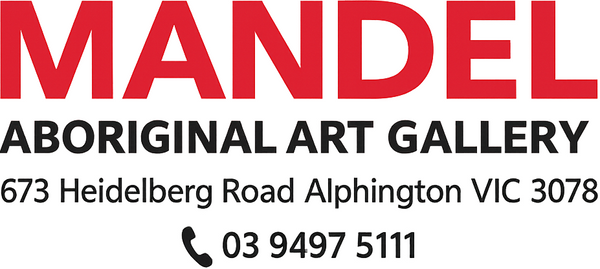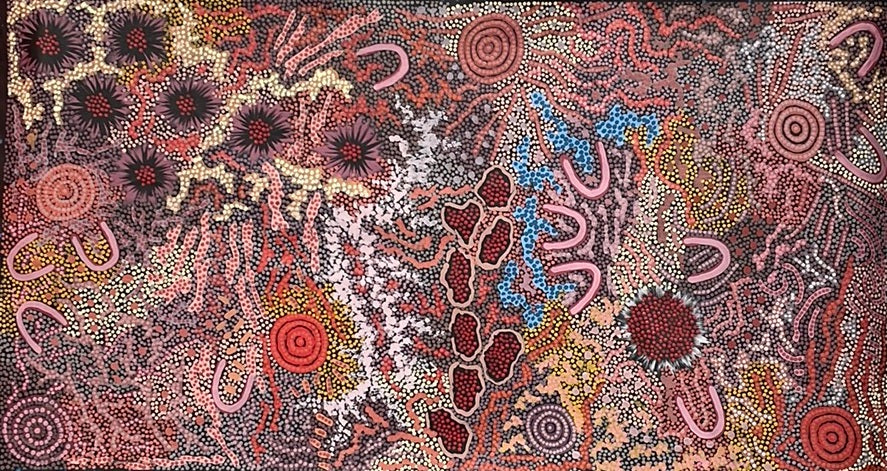
Top 10 Female Aboriginal Artists in Australia
Share
Top 10 famous Aboriginal women artists Australia from Mandel Aboriginal Art Gallery Melbourne
1. Christine Yukenbarri
Christine Yukenbarri is the daughter of two of Balgo’s most famous Australian artists, and Lucy Yukenbarri. Born in 1977 at Balgo, Western Australia (previously Balgo Hills and Balgo Mission). Christine belongs to the Kukatja language group and to the Nakamarra skin Group. Currently she lives with her father and sisters, in a small community at Balgo, Western Australia.
Christine began painting in 2000, regarded as one of Warlayirti artist (Indigenous art and culture center hub) and have become most promising and merging artists. She was taught to paint by her father and mother however given her style in the kinti – kinti (close-close) manner of aboriginal art technique dotting she has been mainly influences by her mother as this was a method first introduced by her mother.
Her unusual and unique executive aboriginal art on canvas and with aboriginal art on glass is recognized as being both innovative and distinctive. Christine’s dreaming and stories revolve around a number of subjects relating to the landscape her late my mother country in the Great Sandy Desert and these include Witjinki (Soak Water), Mungari (Bush Food) and Winpurpurla (Water). Christine is swiftly being identified as one of this country’s outstanding young artists. Each piece of her work portrays a refinement of a more seasoned artist however her energy in her approach to colour is stunning and ultimately defines her unique and individual flair.
2. Anna Petyarre
Anna Petyarre was born within the region of Utopia in 1960 and belongs to the language group of the eatern Ammatyerre. Currently she divides her time living both at her birth plave Boundary Bore (Atneltyeye) and in Alice Springs. Anna is a highly respected Utopia artist within splendid skills and original talents that highlights and instantly defines her painitings and themes.
Anna was introduced to painting whilst still a child with the guidance of her artistic mother the late “Glory Ngale” however she was also surrounded by other famous artists whom she is related to (the late “Emily Kame Kngwarreye” and Kudditji Kngwarreye”) through her grandfather who was bother to Emily and Kudditji father.
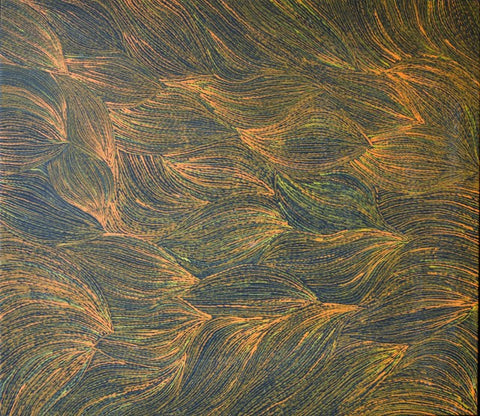
Highly regard for her artistic awareness to detail within her paintings, often consisting of intricate and blended designs that are so meticulous in structure that purposely focus on expressing her ancestral heritage which is major factor in describing Anna’a pallet as original.
It is quite evident from Anna’s key topics which over a of time have seen to have evolved, in earlier times her paintings focused on Bush Yam Seed Dreaming and because of her involvement in traditional Aboriginal Women Ceremonies she also painted “Awelye” (Body Painting) affiliated with Women Ceremony.
Current works tend to illustrate her ancestral country, denoted by fine rows of dots indicating locations of various landmarks such as sand hills and river flood plains along with waterholes and ceremonial sites
3. Dorothy Napangardi
Dorothy Napangardi was born in C1956 at Mina Mina near Lake McKay in the Tanami Desert. Mina Mina is located north of Yuendumu approximately 400Km North West of Alice Springs in Central Australia. Dorothy is considered as a dominant artist of the contemporary Aboriginal Art faction with her paintings showcasing in exhibitions both in Australia and abroad.
Dorothy began her painting career in 1987 through an introduction by her sister Eunice Napangardi whom is also a highly respected artist. The stories/dreaming that are the main focus to Dorothy’s painting revolve around the landscape of her father’s homeland at Lake McKay, depicting this region in her own individual and distinctive technique. Her painting are fashioned by the weaving of grid like of dotted lines, forming a mirco and marco interpretation of the landscape.
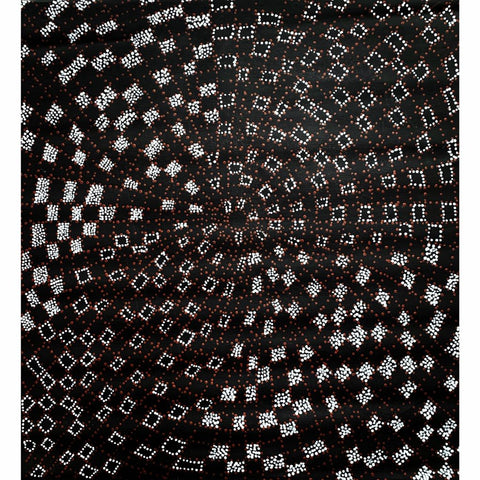
Her works are a representation of the topography of her homeland whilst giving an account of the ancestral tracks. The grid like lines relate to the salt incrustations around the dry clay pans etched with the tracks of the women.
Dorothy has five daughters all of whom have been taught to paint the stories and dreaming which have influenced her own artistic career.
Since being introduced to painting in 1987, Dorothy’s work has been further recognised in that she has received a number of major awards including the 2001 18thTelstra NATSIA Art Award and in 2009 was listed as one of the 50 most collectible artists by the Australian Art Collector magazine. Unfortunately as a result of an accident sadly Dorothy passed away in 2013.
4. Eubena Nampitjin
Eubena Nampitjin exact date of birth is unknown, however it is estimated to be during the 1920s at Tjinjadpa, located west of Jupiter Wells on the Canning Stock Route in Western Australia. She was regarded as a highly respected law women, who provided enormous input and consultation on all topics of law. Whilst the are many talented and exceptional artists from Balgo , Eubena’s reputation as an artist stands above them all.
As a young girl Eubena and her family travelled extensively on the northern fringes of the Great Sandy Desert leading a life of hunters and gatherers along with performing ceremonies and law for the preservation of the country and for their own protection.
Eubena often spoke of the severe conditions of life in the bush and the effect this nomadic existence which contributed to the loss of family either by moving to other areas or through death. With her husband and family they eventually found themselves travelling up the Canning Stock Route to the community of Ballina and from there continued to stay within the mission as it moved about until finally settling at its present location Balgo Hills. In spite of living at Balgo Hills where she initially tendered to herds of goats she would still regularly enjoy a trek back to her country and live the nomadic lifestyle for extended periods.
Eubena and her second husband (Wimmitji) began to paint in the mid 1980’s. Their paintings highlighted a brilliant and elaborate compilation supported by a fondness towards the warm reds, oranges and yellows which has become a trademark of Eubena’s works. Both of their reputations as prominent artists flourished at Balgo, along with Eubena establishing her own status as a solo painter where is now identified as mentioned earlier as Balgo’s leading artist in addition to being classed one of Australia’s premier indigenous painters.
5. Gabriella Possum Nungurrayi
Gabriella Possum was born in 1967 at Mt. Allen, Northern Territory. She is the eldest daughter of one of Australia’s most renowned aboriginal artists, Clifford Possum Tjapaltjarri, who died in 2002. Gabriella began painting at an early age with the guidance of her father, who taught her how to paint and together they have collaborated on many important works. Her younger sister Michelle is also a noteworthy artist in her own right having benefited from the guidance of her late father.
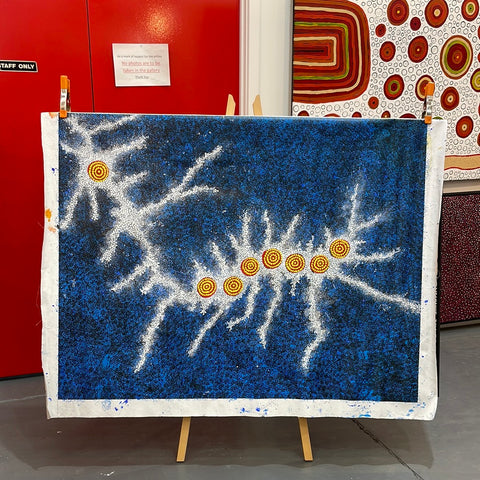
Gabriella’s paintings predominantly depict a series of Dreaming stories passed down to her from her paternal grandmother, Long Rose Nangala and other senior women. Whilst Gabriella paints numerous dreaming her two more prominent relate to Grandmother’s Country – located at Mount Allan in the Northern Territory.This is a place of significance where bush food is in abundance and the paintings depict the women gathering all types of food such as berries, yams and honey ants along with other important landmarks such as water holes.
The second prominent dreaming is titled The Seven Sisters (Milky Way) – other stories include Worm Dreaming, My Father’s Country and Serpent Dreaming from her Anmatyerre heritage.At age 16, Gabriella was the youngest artist to be awarded the Alice Springs Art Prize whilst completing her studies at the Yirara College. Her innate talent and knowledge of women’s dreaming was further enhanced through her association with the Papunya Tula painters, namely her father’s brother Tim Leura Tjapaltjarri and many others.
Gabriella has exhibited extensively throughout Australia and internationally with her art being represented in major private and public gallery collections. Currently Gabriella lives in Melbourne along with her husband and five children.
6. Gloria Petyarre
Gloria Petyarre was born C1945 at Mosquito Bore, Utopia in the Northern Territory. She is part of the Anmatyerre community located just north of Alice Springs. Her overall status as a highly recognised and significant artist within the contemporary Australian Aboriginal Art field is well documented both in Australian and overseas, in fact in 2014 her overall career ranking on the Australian Indigenous Art Market was 13th.
A founding member of the Utopia Women’s Batik Group in the 1970s’ Gloria is regarded as an innovative and dynamic artist; she exerted a great influence on others in the group. Gloria painted the traditional women business subjects, which are predominant in Utopia. Her art has developed to the point that the majority of her works now have no dots at all. Her technique is renowned for its abstract fields and vibrant colours.
In the past Gloria’s main dreaming represents Mountain Devil Lizard, Bean, Emu, Pencil Yam Grass as well as traditional body paint designs worn by women during ceremonies. For some time now the major focus has been towards painting the “Bush Medicine Leaves”.
These paintings depict particular leaves from plant species, which contain medicinal properties. The Aboriginal women from Utopia in Central Australia gather the leaves. The leaves are boiled; resin is added and mixed into a paste, which is used as bush medicine for many ailments.
Using the close tonal values of different colours, creating a dynamic optical intensity continues to develop her paintings to elevated levels of abstraction, continually experimenting with both with line and colour resulting in the optical effects being quite stunning.
7. Jeannie Petyarre
Jeannie Petyarre was born in C 1957 at boundary Bore a tiny community within the Utopia district, and belongs to the Anmatyerre language and therefore commonly referred to as an Anmatyerre woman.
It comes as no surprise that Jeannie is regarded as a highly skilled and talented given the quality of talent that runs within her family. She is the niece of the late and famous “Emily Kame Kngwarreye, her sister Rosemary Petyarre also a highly respected artist in her own right and half sibling Evelyn Pultura (2005 NATSIA award winner). Jeannie does not only rely on the support of her accomplished and artistic family enhance her creative artistic skills, she also draws inspiration from a stunning landscape of her homeland to gain creativity.
A very talented artist who paints several dreaming with Bush Medicine Leaves & Bush Yam being two of the more prominent. Her work is characterized by vibrant fresh colours and designs celebrating the spirit of the yam plant (Kurrajong Tree) as it generates year after year to feed the people. ‘Bush Medicine’ relates to the process of mixing various fruits and plants with animal fat to create medicine. Jeannie paintings are widely sort in both Australia and overseas.
8. Margaret Lewis Napangardi
Margaret Lewis Napangardi is a Warlpiri woman who comes from a family of talented and recognised painters. Born in C1956 at Mount Doreen Station in Central Australia. She is a full blooded sister to the highly acclaimed and respected artist the late “Dorothy Napangardi” and skin sister to the equally profiled artist the late “Judy Watson Napangardi” with whom she lived with at Yuendumu until Judy passed away in 2017.
Whilst Margaret developed her own individual style she has taken on board some acquired aspects of both Judy’s and Dorothy’s pallet which both produced art in contrasting styles. Dorothy’s expressed her works in mainly black and white whereas Judy would utilize a large variety of colours.
Margaret’s current paintings have been restrained in colour, although they still contain some high contrasts of red, yellow and black. Across these styles Margaret draws on elements as mentioned earlier of the refined dot work of her sister and the thick bands of single colours used by Judy Napangardi Watson.
These paintings reflect typical Warlpiri style with the use of strong vibrant colours and microscopic dotting. The main themes of her painting reflect stories relating to her country (Mina Mina) and stories which depict Women‘s Stories and their sacred sites around her homeland of “Mina Mina”. Margaret has featured in exhibitions both in Australia and abroad. Currently Margaret is spending time in Adelaide.
9. Minnie Pwerle
Minnie Pwerle was born in C. 1922 in the region of Utopia. Like her famous sister in law “Emily Kngwarreye” Minnie Pwerle aboriginal artist began her brief but fruitful painting career in 1999 and only painted for approximately seven years.
Her rhythmic and linear artworks representing her country of Atnwengerrp immediately captured the attention many collectors both nationally and internationally. In this time it is exterminated that she produced in excess of 4000 paintings.
Minnie depicts “Awelye Atnwengerrp” by painting a series of lines in alternative widths, patterns and colours. These motifs represent aboriginal body paintings which includes the designs painted on the upper torso of women during ceremonies.
Motifs can vary from aboriginal ceremony to ceremony. In many cases Australian famous bush paintings motifs have as bush fruit, bush melons form part of the body paint, this is quite prevalent in many of Minnie’s works. These designs are usually defined by meandering linear circles and breast motifs defined by different colours, creating very fluid and bold paintings. Minnie had seven children, including Barbara Weir, who is a well-known Aboriginal artist. Minnie lived in Utopia, she continued to paint up until her death in March 2006.
10. Polly Ngala
Polly Ngala was born at Camel Camp Utopia, approximately 300Km east of Alice Springs in the Northern Territory in C1936. Currently Polly divides her time living both at Camel Camp with her family and sisters, (Kathleen Ngala,, Maisy Ngala and Angeline Pwerle Ngala) and also in Alice Springs. Her language group is Anmatyarr and skin name Ngala.
Like many of the Utopian women Polly’s artistic career also began in batik prior to making the transition to acrylic paints on canvas. Initially in the earlier part of her career she was known to assist her sister Kathleen and the late and famous Emily Kame Kngwarreye with whom she shared the same country. Her country from her father’s side is Alparra with her mother coming from Ngwelay or more commonly referred to as Kurrajong Bore. Polly along with her sisters are recognised as senior guardians of the Bush Plum (Arnwekety) Dreaming.
Polly’s painting portray the Bush Plum and how it impacts on her country. The topography is usually illustrated through shades of red, oranges and yellows which highlight the changing of the seasons. This is achieved by the construction of overlapping layers of colour generating a multi-dimensional outcome to reveal the Bush Plum (Ankwekety) and her region Alparra at its finest. Polly is deemed as one of the finest contemporary painters from Utopia with her work having been exhibited both in Australia and abroad.
Her works often feature Aboriginal symbols that reflect the sacred relationship between Country, seasonal cycles, and ancestral stories.
Take your pick at The Mandel Aboriginal Art Gallery and see what more we have to offer!
Call us at 03 94975111 for more information.
